University Name: Resourcing the Organisation Labour Markets Report
VerifiedAdded on 2022/08/21
|16
|4359
|13
Report
AI Summary
This report provides a detailed analysis of labor markets, differentiating between tight and loose market conditions and exploring their implications for organizational resourcing and talent planning. It examines the dynamics of supply and demand, the challenges of recruitment in each market type, and strategies for effective talent management. The report further evaluates various human resource planning activities, including organizational plan analysis, HR objective analysis, and forecasting labor demands, with specific examples to illustrate practical application. The discussion includes recommendations for successful resourcing and succession planning, highlighting the importance of aligning HR strategies with overall business objectives to ensure optimal workforce utilization and organizational success. The report is a comprehensive guide to understanding and navigating the complexities of the labor market.
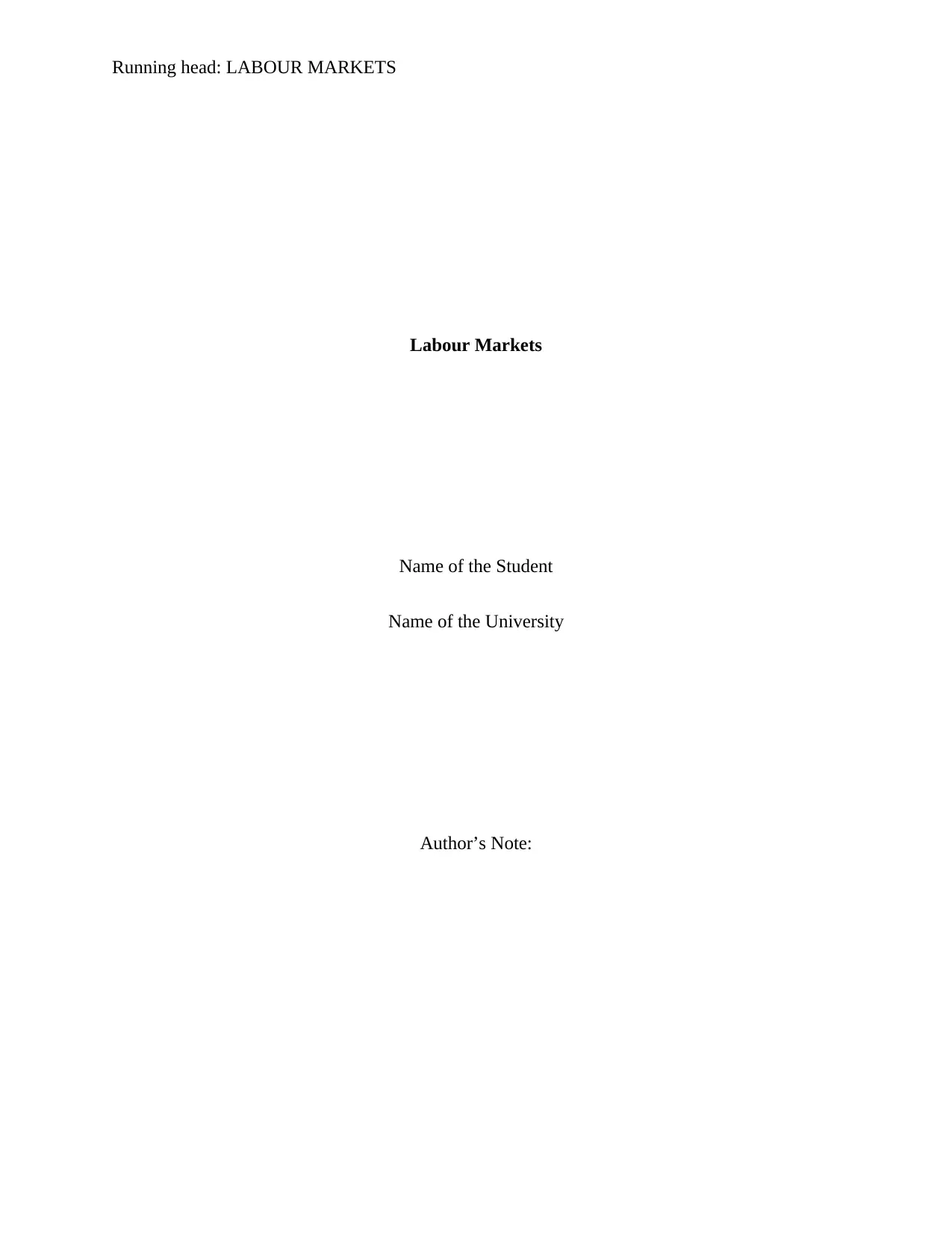
Running head: LABOUR MARKETS
Labour Markets
Name of the Student
Name of the University
Author’s Note:
Labour Markets
Name of the Student
Name of the University
Author’s Note:
Paraphrase This Document
Need a fresh take? Get an instant paraphrase of this document with our AI Paraphraser
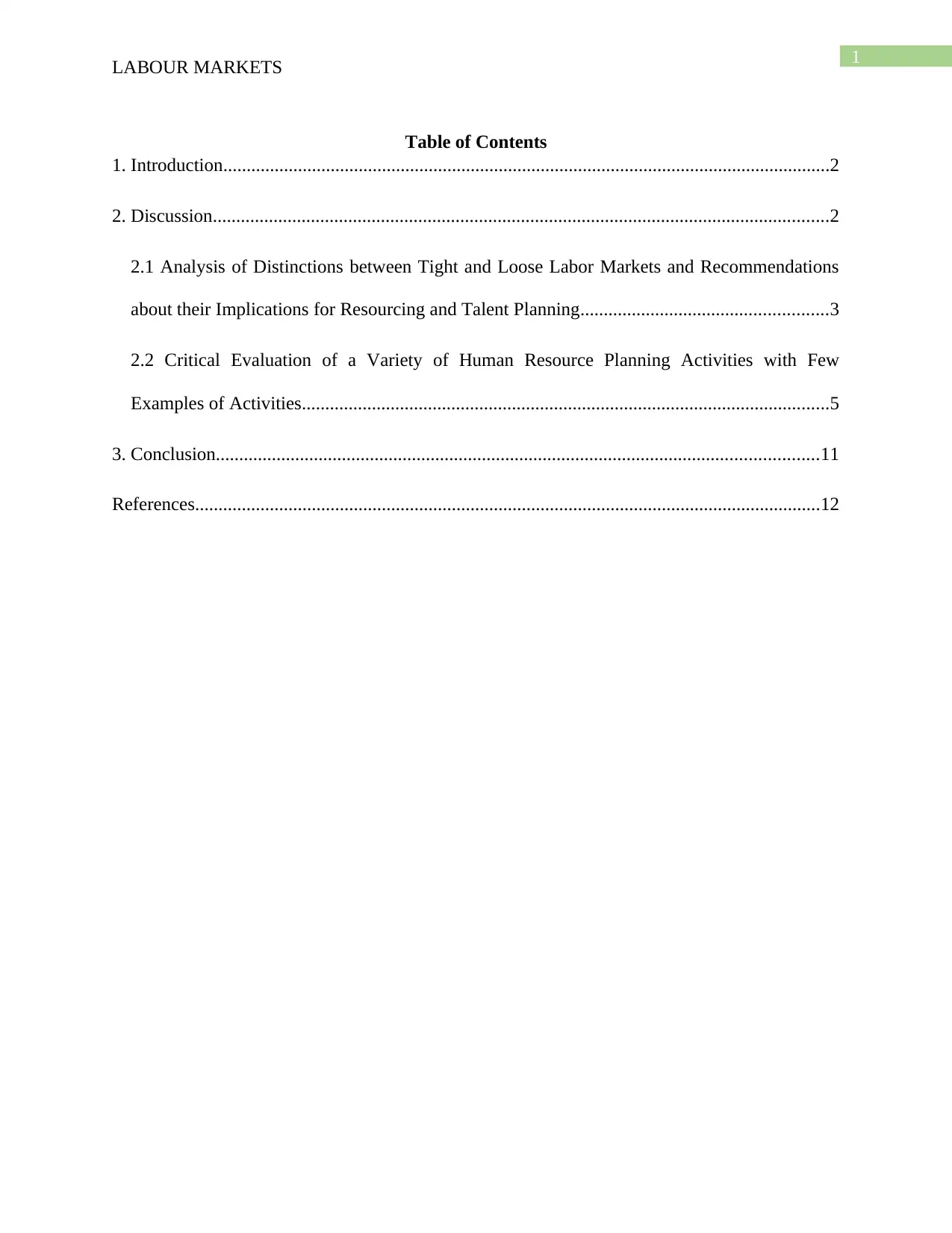
1
LABOUR MARKETS
Table of Contents
1. Introduction..................................................................................................................................2
2. Discussion....................................................................................................................................2
2.1 Analysis of Distinctions between Tight and Loose Labor Markets and Recommendations
about their Implications for Resourcing and Talent Planning.....................................................3
2.2 Critical Evaluation of a Variety of Human Resource Planning Activities with Few
Examples of Activities.................................................................................................................5
3. Conclusion.................................................................................................................................11
References......................................................................................................................................12
LABOUR MARKETS
Table of Contents
1. Introduction..................................................................................................................................2
2. Discussion....................................................................................................................................2
2.1 Analysis of Distinctions between Tight and Loose Labor Markets and Recommendations
about their Implications for Resourcing and Talent Planning.....................................................3
2.2 Critical Evaluation of a Variety of Human Resource Planning Activities with Few
Examples of Activities.................................................................................................................5
3. Conclusion.................................................................................................................................11
References......................................................................................................................................12
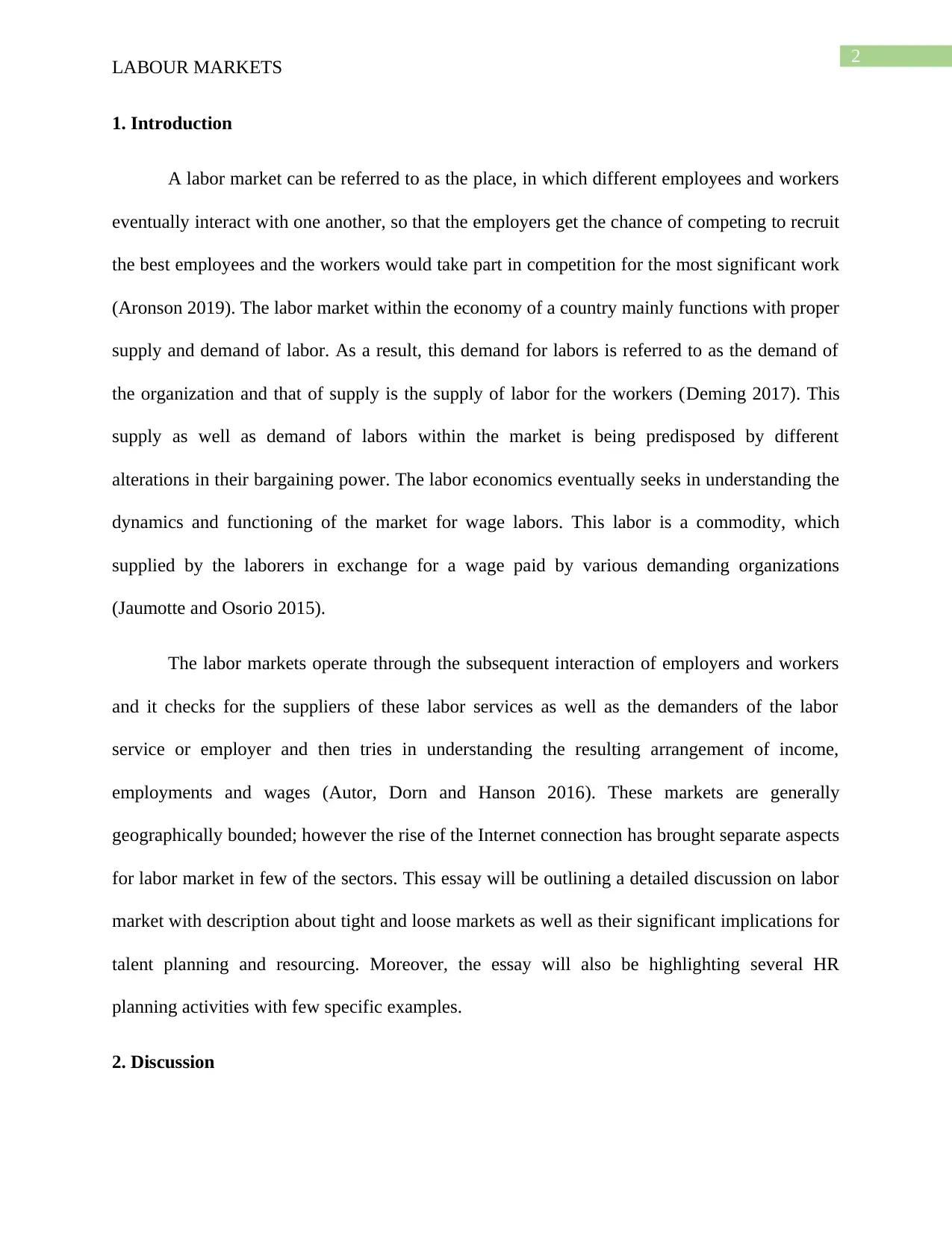
2
LABOUR MARKETS
1. Introduction
A labor market can be referred to as the place, in which different employees and workers
eventually interact with one another, so that the employers get the chance of competing to recruit
the best employees and the workers would take part in competition for the most significant work
(Aronson 2019). The labor market within the economy of a country mainly functions with proper
supply and demand of labor. As a result, this demand for labors is referred to as the demand of
the organization and that of supply is the supply of labor for the workers (Deming 2017). This
supply as well as demand of labors within the market is being predisposed by different
alterations in their bargaining power. The labor economics eventually seeks in understanding the
dynamics and functioning of the market for wage labors. This labor is a commodity, which
supplied by the laborers in exchange for a wage paid by various demanding organizations
(Jaumotte and Osorio 2015).
The labor markets operate through the subsequent interaction of employers and workers
and it checks for the suppliers of these labor services as well as the demanders of the labor
service or employer and then tries in understanding the resulting arrangement of income,
employments and wages (Autor, Dorn and Hanson 2016). These markets are generally
geographically bounded; however the rise of the Internet connection has brought separate aspects
for labor market in few of the sectors. This essay will be outlining a detailed discussion on labor
market with description about tight and loose markets as well as their significant implications for
talent planning and resourcing. Moreover, the essay will also be highlighting several HR
planning activities with few specific examples.
2. Discussion
LABOUR MARKETS
1. Introduction
A labor market can be referred to as the place, in which different employees and workers
eventually interact with one another, so that the employers get the chance of competing to recruit
the best employees and the workers would take part in competition for the most significant work
(Aronson 2019). The labor market within the economy of a country mainly functions with proper
supply and demand of labor. As a result, this demand for labors is referred to as the demand of
the organization and that of supply is the supply of labor for the workers (Deming 2017). This
supply as well as demand of labors within the market is being predisposed by different
alterations in their bargaining power. The labor economics eventually seeks in understanding the
dynamics and functioning of the market for wage labors. This labor is a commodity, which
supplied by the laborers in exchange for a wage paid by various demanding organizations
(Jaumotte and Osorio 2015).
The labor markets operate through the subsequent interaction of employers and workers
and it checks for the suppliers of these labor services as well as the demanders of the labor
service or employer and then tries in understanding the resulting arrangement of income,
employments and wages (Autor, Dorn and Hanson 2016). These markets are generally
geographically bounded; however the rise of the Internet connection has brought separate aspects
for labor market in few of the sectors. This essay will be outlining a detailed discussion on labor
market with description about tight and loose markets as well as their significant implications for
talent planning and resourcing. Moreover, the essay will also be highlighting several HR
planning activities with few specific examples.
2. Discussion
⊘ This is a preview!⊘
Do you want full access?
Subscribe today to unlock all pages.

Trusted by 1+ million students worldwide
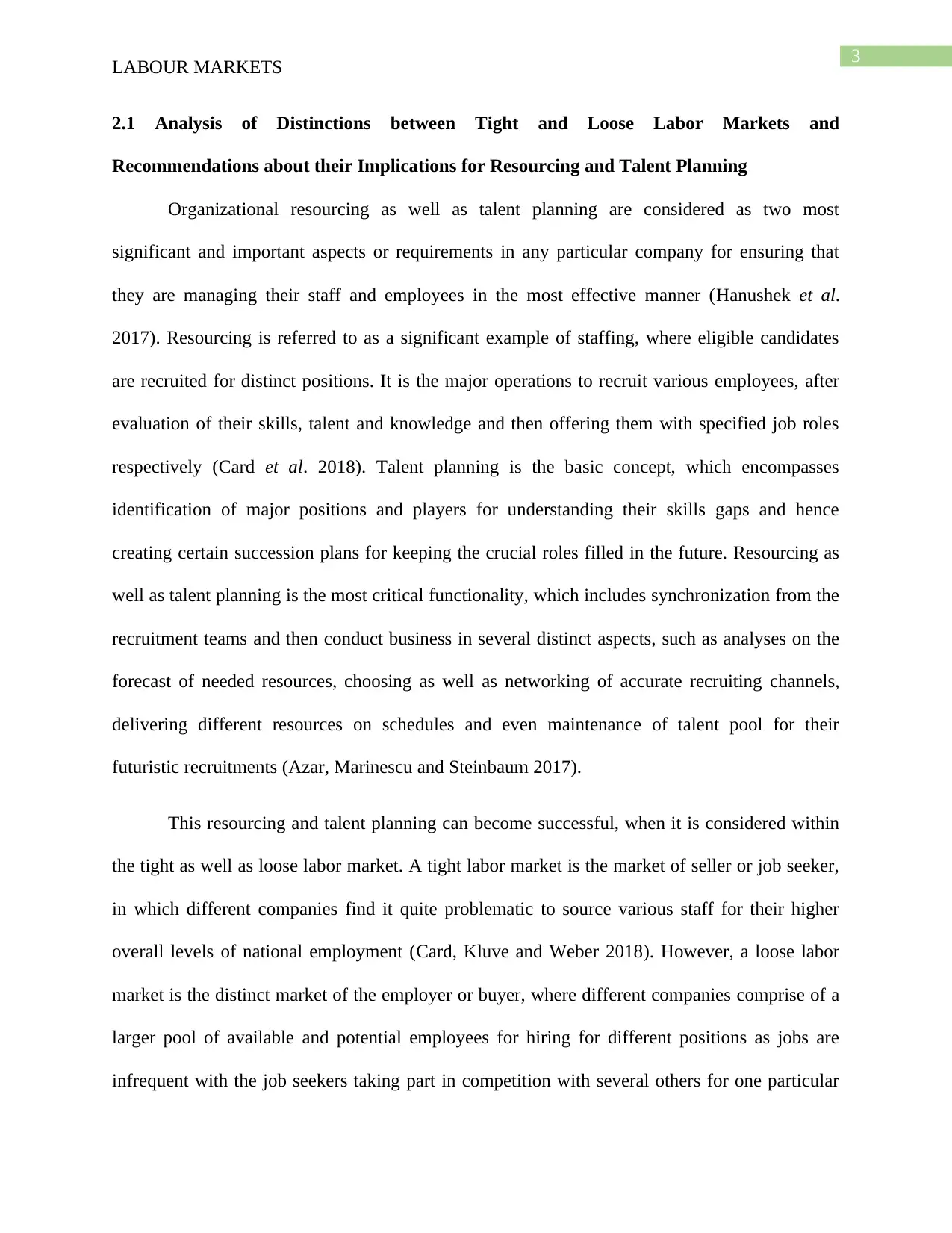
3
LABOUR MARKETS
2.1 Analysis of Distinctions between Tight and Loose Labor Markets and
Recommendations about their Implications for Resourcing and Talent Planning
Organizational resourcing as well as talent planning are considered as two most
significant and important aspects or requirements in any particular company for ensuring that
they are managing their staff and employees in the most effective manner (Hanushek et al.
2017). Resourcing is referred to as a significant example of staffing, where eligible candidates
are recruited for distinct positions. It is the major operations to recruit various employees, after
evaluation of their skills, talent and knowledge and then offering them with specified job roles
respectively (Card et al. 2018). Talent planning is the basic concept, which encompasses
identification of major positions and players for understanding their skills gaps and hence
creating certain succession plans for keeping the crucial roles filled in the future. Resourcing as
well as talent planning is the most critical functionality, which includes synchronization from the
recruitment teams and then conduct business in several distinct aspects, such as analyses on the
forecast of needed resources, choosing as well as networking of accurate recruiting channels,
delivering different resources on schedules and even maintenance of talent pool for their
futuristic recruitments (Azar, Marinescu and Steinbaum 2017).
This resourcing and talent planning can become successful, when it is considered within
the tight as well as loose labor market. A tight labor market is the market of seller or job seeker,
in which different companies find it quite problematic to source various staff for their higher
overall levels of national employment (Card, Kluve and Weber 2018). However, a loose labor
market is the distinct market of the employer or buyer, where different companies comprise of a
larger pool of available and potential employees for hiring for different positions as jobs are
infrequent with the job seekers taking part in competition with several others for one particular
LABOUR MARKETS
2.1 Analysis of Distinctions between Tight and Loose Labor Markets and
Recommendations about their Implications for Resourcing and Talent Planning
Organizational resourcing as well as talent planning are considered as two most
significant and important aspects or requirements in any particular company for ensuring that
they are managing their staff and employees in the most effective manner (Hanushek et al.
2017). Resourcing is referred to as a significant example of staffing, where eligible candidates
are recruited for distinct positions. It is the major operations to recruit various employees, after
evaluation of their skills, talent and knowledge and then offering them with specified job roles
respectively (Card et al. 2018). Talent planning is the basic concept, which encompasses
identification of major positions and players for understanding their skills gaps and hence
creating certain succession plans for keeping the crucial roles filled in the future. Resourcing as
well as talent planning is the most critical functionality, which includes synchronization from the
recruitment teams and then conduct business in several distinct aspects, such as analyses on the
forecast of needed resources, choosing as well as networking of accurate recruiting channels,
delivering different resources on schedules and even maintenance of talent pool for their
futuristic recruitments (Azar, Marinescu and Steinbaum 2017).
This resourcing and talent planning can become successful, when it is considered within
the tight as well as loose labor market. A tight labor market is the market of seller or job seeker,
in which different companies find it quite problematic to source various staff for their higher
overall levels of national employment (Card, Kluve and Weber 2018). However, a loose labor
market is the distinct market of the employer or buyer, where different companies comprise of a
larger pool of available and potential employees for hiring for different positions as jobs are
infrequent with the job seekers taking part in competition with several others for one particular
Paraphrase This Document
Need a fresh take? Get an instant paraphrase of this document with our AI Paraphraser
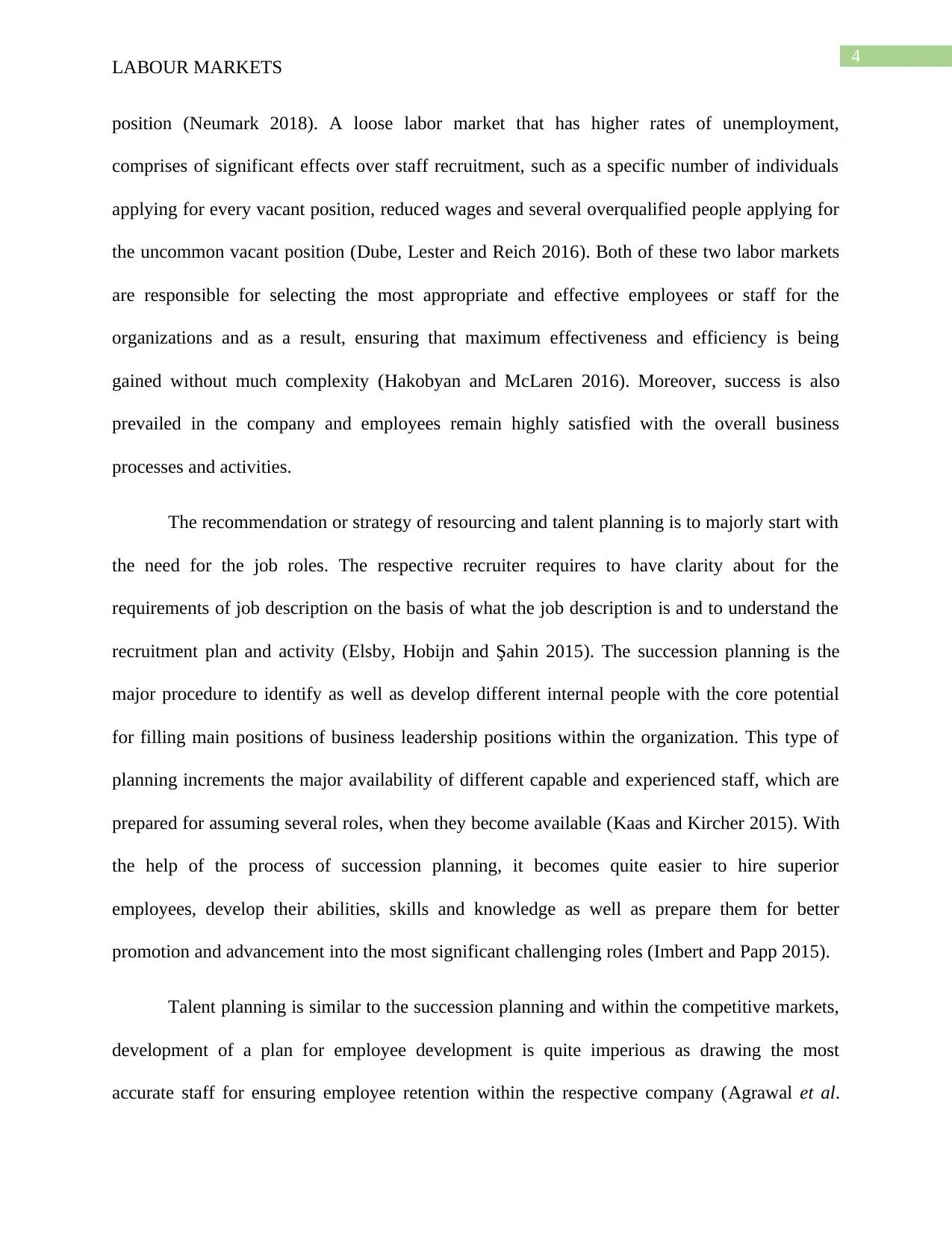
4
LABOUR MARKETS
position (Neumark 2018). A loose labor market that has higher rates of unemployment,
comprises of significant effects over staff recruitment, such as a specific number of individuals
applying for every vacant position, reduced wages and several overqualified people applying for
the uncommon vacant position (Dube, Lester and Reich 2016). Both of these two labor markets
are responsible for selecting the most appropriate and effective employees or staff for the
organizations and as a result, ensuring that maximum effectiveness and efficiency is being
gained without much complexity (Hakobyan and McLaren 2016). Moreover, success is also
prevailed in the company and employees remain highly satisfied with the overall business
processes and activities.
The recommendation or strategy of resourcing and talent planning is to majorly start with
the need for the job roles. The respective recruiter requires to have clarity about for the
requirements of job description on the basis of what the job description is and to understand the
recruitment plan and activity (Elsby, Hobijn and Şahin 2015). The succession planning is the
major procedure to identify as well as develop different internal people with the core potential
for filling main positions of business leadership positions within the organization. This type of
planning increments the major availability of different capable and experienced staff, which are
prepared for assuming several roles, when they become available (Kaas and Kircher 2015). With
the help of the process of succession planning, it becomes quite easier to hire superior
employees, develop their abilities, skills and knowledge as well as prepare them for better
promotion and advancement into the most significant challenging roles (Imbert and Papp 2015).
Talent planning is similar to the succession planning and within the competitive markets,
development of a plan for employee development is quite imperious as drawing the most
accurate staff for ensuring employee retention within the respective company (Agrawal et al.
LABOUR MARKETS
position (Neumark 2018). A loose labor market that has higher rates of unemployment,
comprises of significant effects over staff recruitment, such as a specific number of individuals
applying for every vacant position, reduced wages and several overqualified people applying for
the uncommon vacant position (Dube, Lester and Reich 2016). Both of these two labor markets
are responsible for selecting the most appropriate and effective employees or staff for the
organizations and as a result, ensuring that maximum effectiveness and efficiency is being
gained without much complexity (Hakobyan and McLaren 2016). Moreover, success is also
prevailed in the company and employees remain highly satisfied with the overall business
processes and activities.
The recommendation or strategy of resourcing and talent planning is to majorly start with
the need for the job roles. The respective recruiter requires to have clarity about for the
requirements of job description on the basis of what the job description is and to understand the
recruitment plan and activity (Elsby, Hobijn and Şahin 2015). The succession planning is the
major procedure to identify as well as develop different internal people with the core potential
for filling main positions of business leadership positions within the organization. This type of
planning increments the major availability of different capable and experienced staff, which are
prepared for assuming several roles, when they become available (Kaas and Kircher 2015). With
the help of the process of succession planning, it becomes quite easier to hire superior
employees, develop their abilities, skills and knowledge as well as prepare them for better
promotion and advancement into the most significant challenging roles (Imbert and Papp 2015).
Talent planning is similar to the succession planning and within the competitive markets,
development of a plan for employee development is quite imperious as drawing the most
accurate staff for ensuring employee retention within the respective company (Agrawal et al.
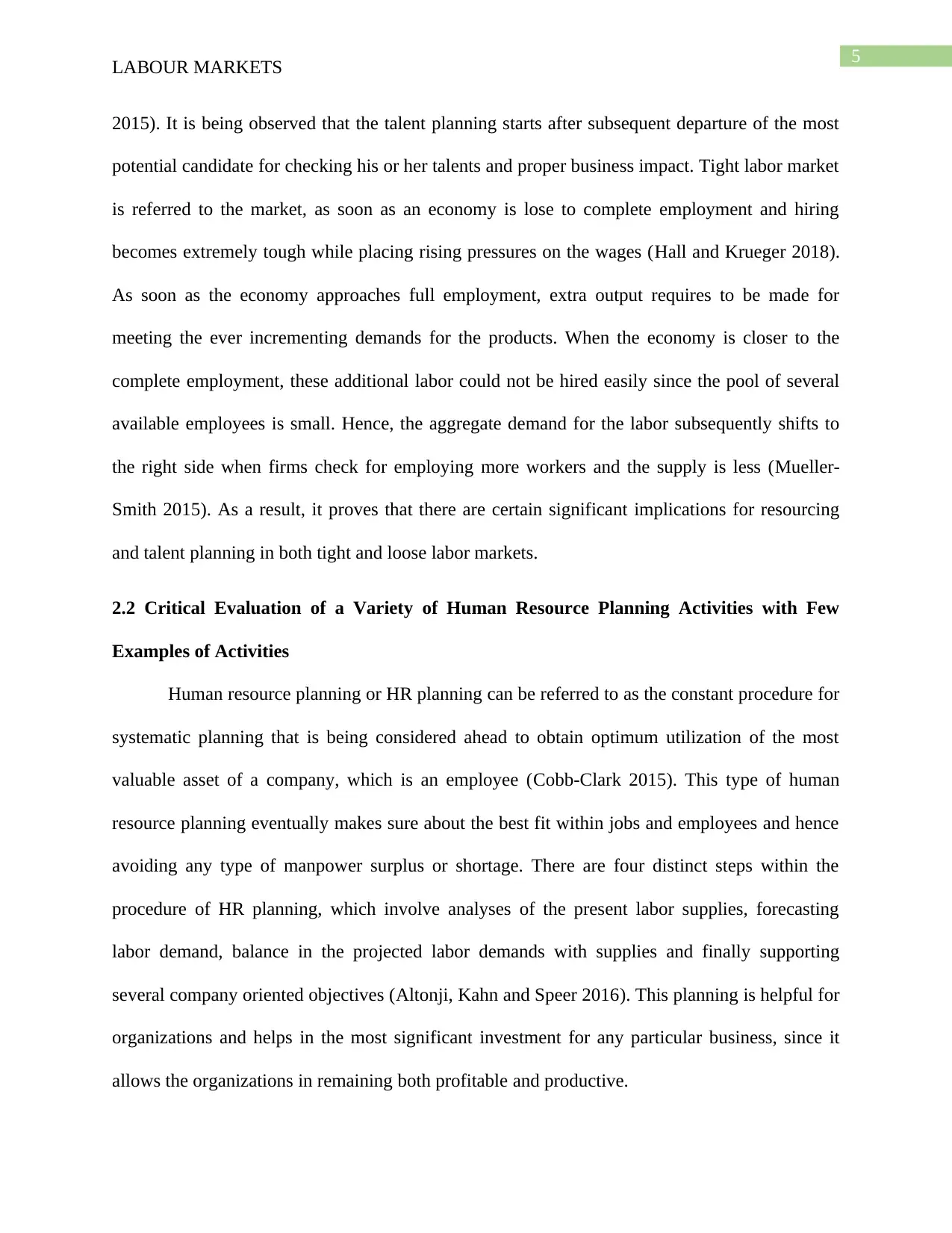
5
LABOUR MARKETS
2015). It is being observed that the talent planning starts after subsequent departure of the most
potential candidate for checking his or her talents and proper business impact. Tight labor market
is referred to the market, as soon as an economy is lose to complete employment and hiring
becomes extremely tough while placing rising pressures on the wages (Hall and Krueger 2018).
As soon as the economy approaches full employment, extra output requires to be made for
meeting the ever incrementing demands for the products. When the economy is closer to the
complete employment, these additional labor could not be hired easily since the pool of several
available employees is small. Hence, the aggregate demand for the labor subsequently shifts to
the right side when firms check for employing more workers and the supply is less (Mueller-
Smith 2015). As a result, it proves that there are certain significant implications for resourcing
and talent planning in both tight and loose labor markets.
2.2 Critical Evaluation of a Variety of Human Resource Planning Activities with Few
Examples of Activities
Human resource planning or HR planning can be referred to as the constant procedure for
systematic planning that is being considered ahead to obtain optimum utilization of the most
valuable asset of a company, which is an employee (Cobb-Clark 2015). This type of human
resource planning eventually makes sure about the best fit within jobs and employees and hence
avoiding any type of manpower surplus or shortage. There are four distinct steps within the
procedure of HR planning, which involve analyses of the present labor supplies, forecasting
labor demand, balance in the projected labor demands with supplies and finally supporting
several company oriented objectives (Altonji, Kahn and Speer 2016). This planning is helpful for
organizations and helps in the most significant investment for any particular business, since it
allows the organizations in remaining both profitable and productive.
LABOUR MARKETS
2015). It is being observed that the talent planning starts after subsequent departure of the most
potential candidate for checking his or her talents and proper business impact. Tight labor market
is referred to the market, as soon as an economy is lose to complete employment and hiring
becomes extremely tough while placing rising pressures on the wages (Hall and Krueger 2018).
As soon as the economy approaches full employment, extra output requires to be made for
meeting the ever incrementing demands for the products. When the economy is closer to the
complete employment, these additional labor could not be hired easily since the pool of several
available employees is small. Hence, the aggregate demand for the labor subsequently shifts to
the right side when firms check for employing more workers and the supply is less (Mueller-
Smith 2015). As a result, it proves that there are certain significant implications for resourcing
and talent planning in both tight and loose labor markets.
2.2 Critical Evaluation of a Variety of Human Resource Planning Activities with Few
Examples of Activities
Human resource planning or HR planning can be referred to as the constant procedure for
systematic planning that is being considered ahead to obtain optimum utilization of the most
valuable asset of a company, which is an employee (Cobb-Clark 2015). This type of human
resource planning eventually makes sure about the best fit within jobs and employees and hence
avoiding any type of manpower surplus or shortage. There are four distinct steps within the
procedure of HR planning, which involve analyses of the present labor supplies, forecasting
labor demand, balance in the projected labor demands with supplies and finally supporting
several company oriented objectives (Altonji, Kahn and Speer 2016). This planning is helpful for
organizations and helps in the most significant investment for any particular business, since it
allows the organizations in remaining both profitable and productive.
⊘ This is a preview!⊘
Do you want full access?
Subscribe today to unlock all pages.

Trusted by 1+ million students worldwide
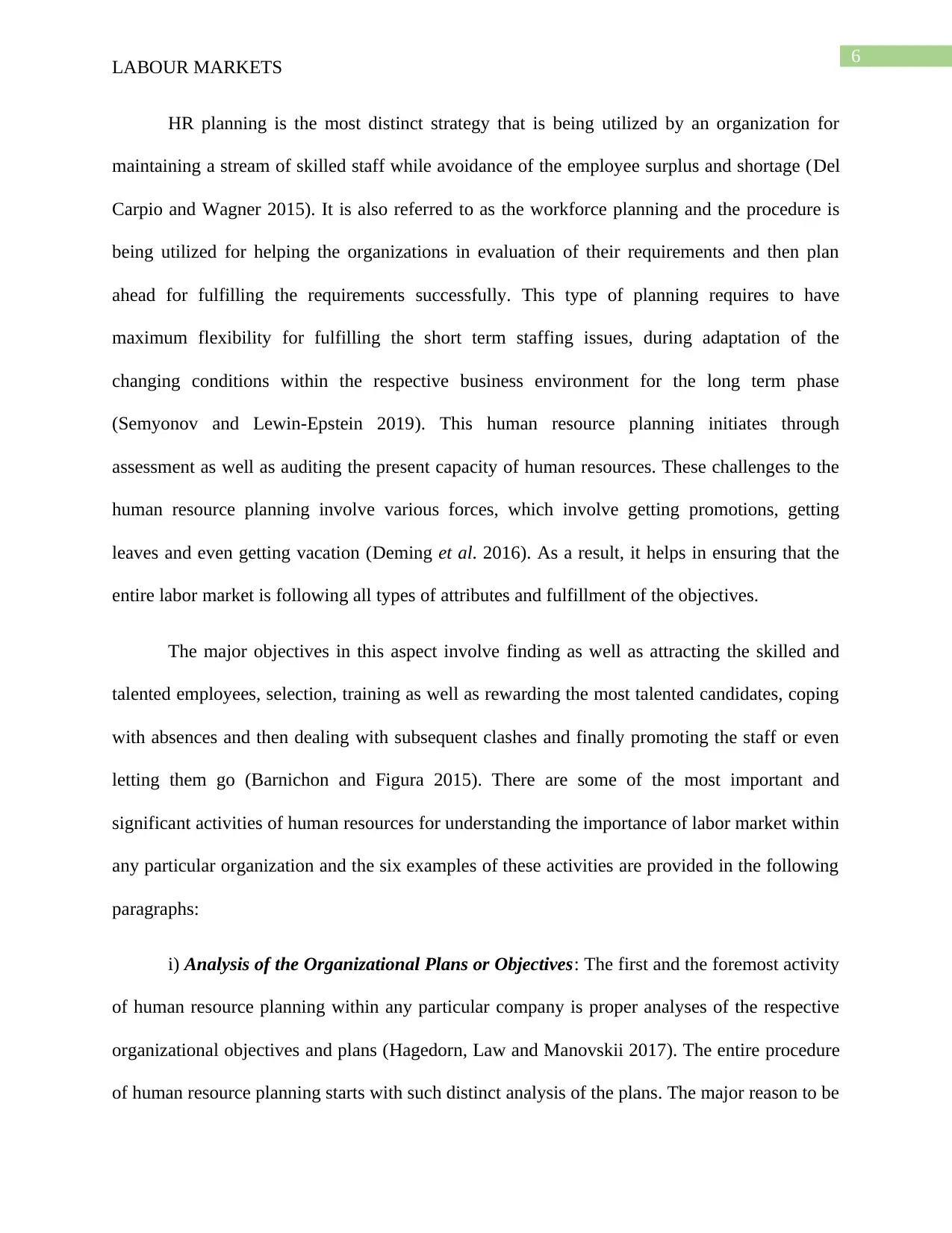
6
LABOUR MARKETS
HR planning is the most distinct strategy that is being utilized by an organization for
maintaining a stream of skilled staff while avoidance of the employee surplus and shortage (Del
Carpio and Wagner 2015). It is also referred to as the workforce planning and the procedure is
being utilized for helping the organizations in evaluation of their requirements and then plan
ahead for fulfilling the requirements successfully. This type of planning requires to have
maximum flexibility for fulfilling the short term staffing issues, during adaptation of the
changing conditions within the respective business environment for the long term phase
(Semyonov and Lewin-Epstein 2019). This human resource planning initiates through
assessment as well as auditing the present capacity of human resources. These challenges to the
human resource planning involve various forces, which involve getting promotions, getting
leaves and even getting vacation (Deming et al. 2016). As a result, it helps in ensuring that the
entire labor market is following all types of attributes and fulfillment of the objectives.
The major objectives in this aspect involve finding as well as attracting the skilled and
talented employees, selection, training as well as rewarding the most talented candidates, coping
with absences and then dealing with subsequent clashes and finally promoting the staff or even
letting them go (Barnichon and Figura 2015). There are some of the most important and
significant activities of human resources for understanding the importance of labor market within
any particular organization and the six examples of these activities are provided in the following
paragraphs:
i) Analysis of the Organizational Plans or Objectives: The first and the foremost activity
of human resource planning within any particular company is proper analyses of the respective
organizational objectives and plans (Hagedorn, Law and Manovskii 2017). The entire procedure
of human resource planning starts with such distinct analysis of the plans. The major reason to be
LABOUR MARKETS
HR planning is the most distinct strategy that is being utilized by an organization for
maintaining a stream of skilled staff while avoidance of the employee surplus and shortage (Del
Carpio and Wagner 2015). It is also referred to as the workforce planning and the procedure is
being utilized for helping the organizations in evaluation of their requirements and then plan
ahead for fulfilling the requirements successfully. This type of planning requires to have
maximum flexibility for fulfilling the short term staffing issues, during adaptation of the
changing conditions within the respective business environment for the long term phase
(Semyonov and Lewin-Epstein 2019). This human resource planning initiates through
assessment as well as auditing the present capacity of human resources. These challenges to the
human resource planning involve various forces, which involve getting promotions, getting
leaves and even getting vacation (Deming et al. 2016). As a result, it helps in ensuring that the
entire labor market is following all types of attributes and fulfillment of the objectives.
The major objectives in this aspect involve finding as well as attracting the skilled and
talented employees, selection, training as well as rewarding the most talented candidates, coping
with absences and then dealing with subsequent clashes and finally promoting the staff or even
letting them go (Barnichon and Figura 2015). There are some of the most important and
significant activities of human resources for understanding the importance of labor market within
any particular organization and the six examples of these activities are provided in the following
paragraphs:
i) Analysis of the Organizational Plans or Objectives: The first and the foremost activity
of human resource planning within any particular company is proper analyses of the respective
organizational objectives and plans (Hagedorn, Law and Manovskii 2017). The entire procedure
of human resource planning starts with such distinct analysis of the plans. The major reason to be
Paraphrase This Document
Need a fresh take? Get an instant paraphrase of this document with our AI Paraphraser
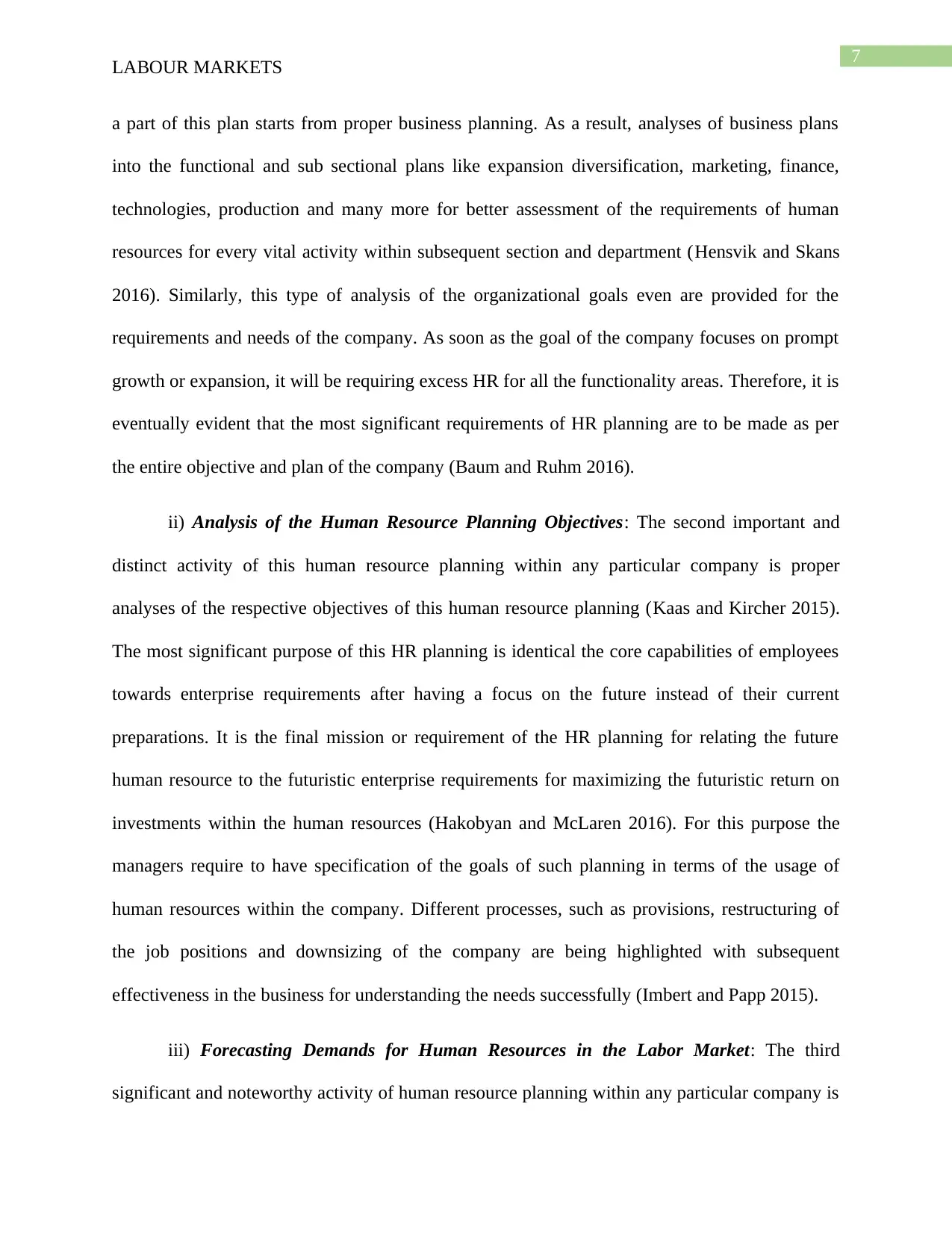
7
LABOUR MARKETS
a part of this plan starts from proper business planning. As a result, analyses of business plans
into the functional and sub sectional plans like expansion diversification, marketing, finance,
technologies, production and many more for better assessment of the requirements of human
resources for every vital activity within subsequent section and department (Hensvik and Skans
2016). Similarly, this type of analysis of the organizational goals even are provided for the
requirements and needs of the company. As soon as the goal of the company focuses on prompt
growth or expansion, it will be requiring excess HR for all the functionality areas. Therefore, it is
eventually evident that the most significant requirements of HR planning are to be made as per
the entire objective and plan of the company (Baum and Ruhm 2016).
ii) Analysis of the Human Resource Planning Objectives: The second important and
distinct activity of this human resource planning within any particular company is proper
analyses of the respective objectives of this human resource planning (Kaas and Kircher 2015).
The most significant purpose of this HR planning is identical the core capabilities of employees
towards enterprise requirements after having a focus on the future instead of their current
preparations. It is the final mission or requirement of the HR planning for relating the future
human resource to the futuristic enterprise requirements for maximizing the futuristic return on
investments within the human resources (Hakobyan and McLaren 2016). For this purpose the
managers require to have specification of the goals of such planning in terms of the usage of
human resources within the company. Different processes, such as provisions, restructuring of
the job positions and downsizing of the company are being highlighted with subsequent
effectiveness in the business for understanding the needs successfully (Imbert and Papp 2015).
iii) Forecasting Demands for Human Resources in the Labor Market: The third
significant and noteworthy activity of human resource planning within any particular company is
LABOUR MARKETS
a part of this plan starts from proper business planning. As a result, analyses of business plans
into the functional and sub sectional plans like expansion diversification, marketing, finance,
technologies, production and many more for better assessment of the requirements of human
resources for every vital activity within subsequent section and department (Hensvik and Skans
2016). Similarly, this type of analysis of the organizational goals even are provided for the
requirements and needs of the company. As soon as the goal of the company focuses on prompt
growth or expansion, it will be requiring excess HR for all the functionality areas. Therefore, it is
eventually evident that the most significant requirements of HR planning are to be made as per
the entire objective and plan of the company (Baum and Ruhm 2016).
ii) Analysis of the Human Resource Planning Objectives: The second important and
distinct activity of this human resource planning within any particular company is proper
analyses of the respective objectives of this human resource planning (Kaas and Kircher 2015).
The most significant purpose of this HR planning is identical the core capabilities of employees
towards enterprise requirements after having a focus on the future instead of their current
preparations. It is the final mission or requirement of the HR planning for relating the future
human resource to the futuristic enterprise requirements for maximizing the futuristic return on
investments within the human resources (Hakobyan and McLaren 2016). For this purpose the
managers require to have specification of the goals of such planning in terms of the usage of
human resources within the company. Different processes, such as provisions, restructuring of
the job positions and downsizing of the company are being highlighted with subsequent
effectiveness in the business for understanding the needs successfully (Imbert and Papp 2015).
iii) Forecasting Demands for Human Resources in the Labor Market: The third
significant and noteworthy activity of human resource planning within any particular company is
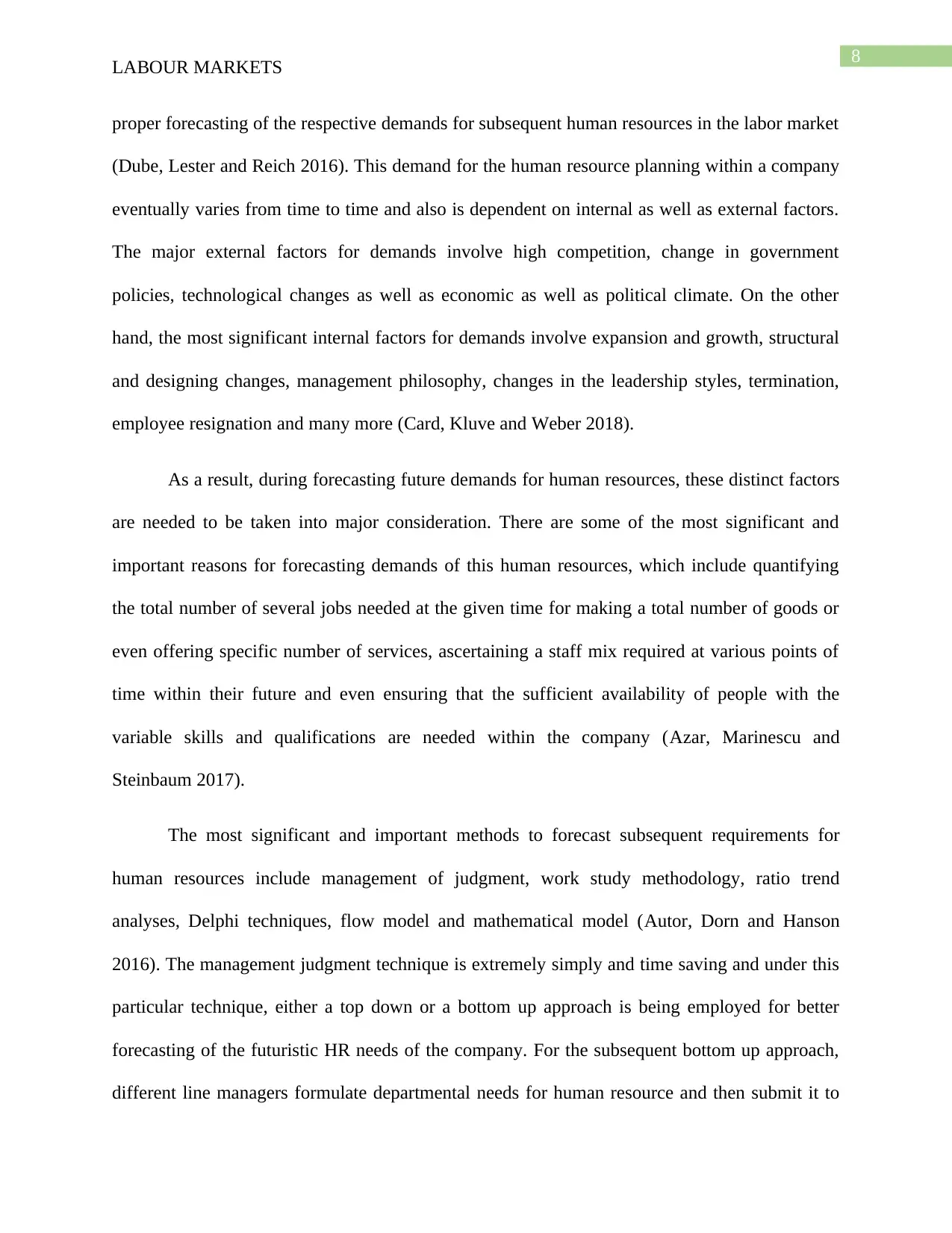
8
LABOUR MARKETS
proper forecasting of the respective demands for subsequent human resources in the labor market
(Dube, Lester and Reich 2016). This demand for the human resource planning within a company
eventually varies from time to time and also is dependent on internal as well as external factors.
The major external factors for demands involve high competition, change in government
policies, technological changes as well as economic as well as political climate. On the other
hand, the most significant internal factors for demands involve expansion and growth, structural
and designing changes, management philosophy, changes in the leadership styles, termination,
employee resignation and many more (Card, Kluve and Weber 2018).
As a result, during forecasting future demands for human resources, these distinct factors
are needed to be taken into major consideration. There are some of the most significant and
important reasons for forecasting demands of this human resources, which include quantifying
the total number of several jobs needed at the given time for making a total number of goods or
even offering specific number of services, ascertaining a staff mix required at various points of
time within their future and even ensuring that the sufficient availability of people with the
variable skills and qualifications are needed within the company (Azar, Marinescu and
Steinbaum 2017).
The most significant and important methods to forecast subsequent requirements for
human resources include management of judgment, work study methodology, ratio trend
analyses, Delphi techniques, flow model and mathematical model (Autor, Dorn and Hanson
2016). The management judgment technique is extremely simply and time saving and under this
particular technique, either a top down or a bottom up approach is being employed for better
forecasting of the futuristic HR needs of the company. For the subsequent bottom up approach,
different line managers formulate departmental needs for human resource and then submit it to
LABOUR MARKETS
proper forecasting of the respective demands for subsequent human resources in the labor market
(Dube, Lester and Reich 2016). This demand for the human resource planning within a company
eventually varies from time to time and also is dependent on internal as well as external factors.
The major external factors for demands involve high competition, change in government
policies, technological changes as well as economic as well as political climate. On the other
hand, the most significant internal factors for demands involve expansion and growth, structural
and designing changes, management philosophy, changes in the leadership styles, termination,
employee resignation and many more (Card, Kluve and Weber 2018).
As a result, during forecasting future demands for human resources, these distinct factors
are needed to be taken into major consideration. There are some of the most significant and
important reasons for forecasting demands of this human resources, which include quantifying
the total number of several jobs needed at the given time for making a total number of goods or
even offering specific number of services, ascertaining a staff mix required at various points of
time within their future and even ensuring that the sufficient availability of people with the
variable skills and qualifications are needed within the company (Azar, Marinescu and
Steinbaum 2017).
The most significant and important methods to forecast subsequent requirements for
human resources include management of judgment, work study methodology, ratio trend
analyses, Delphi techniques, flow model and mathematical model (Autor, Dorn and Hanson
2016). The management judgment technique is extremely simply and time saving and under this
particular technique, either a top down or a bottom up approach is being employed for better
forecasting of the futuristic HR needs of the company. For the subsequent bottom up approach,
different line managers formulate departmental needs for human resource and then submit it to
⊘ This is a preview!⊘
Do you want full access?
Subscribe today to unlock all pages.

Trusted by 1+ million students worldwide
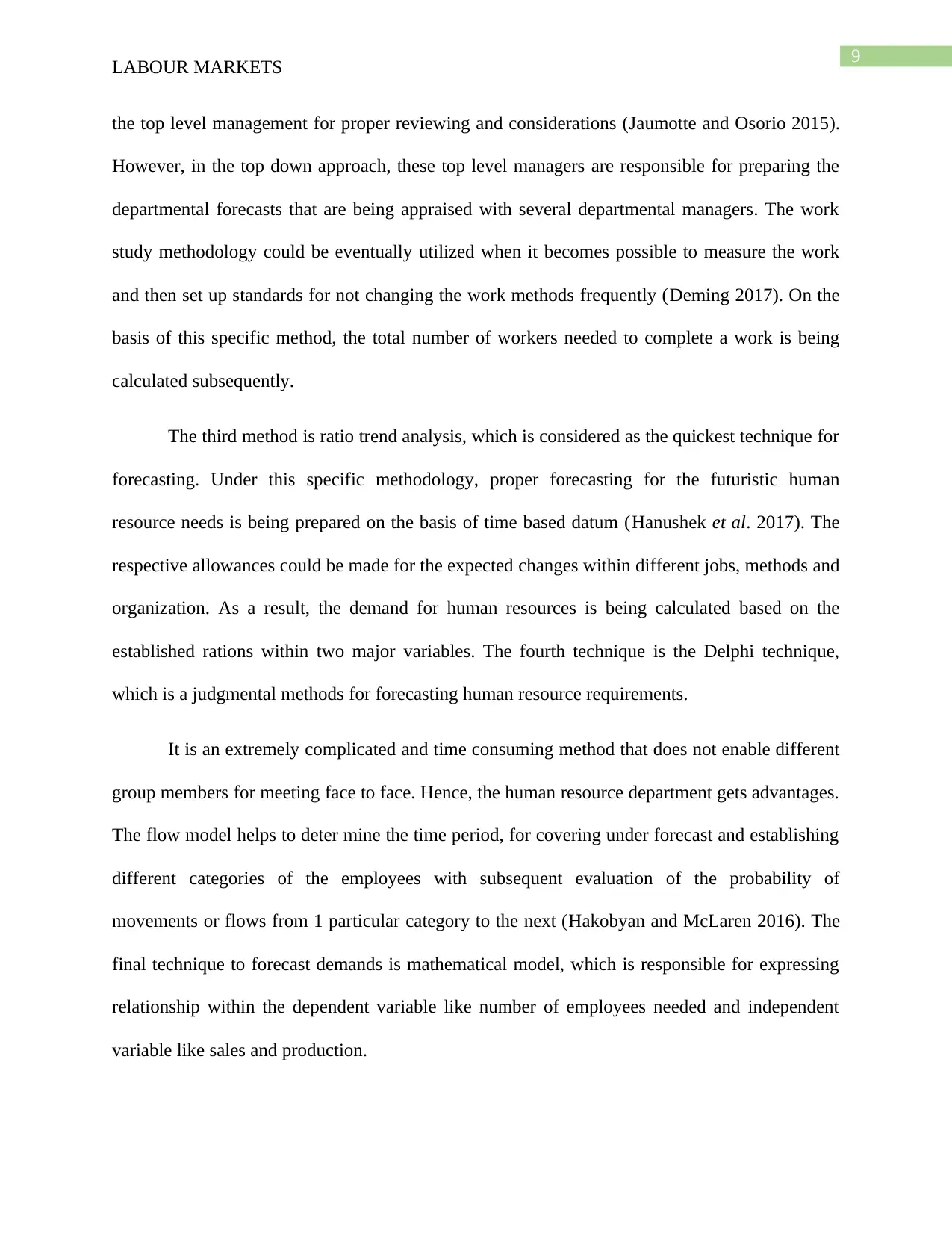
9
LABOUR MARKETS
the top level management for proper reviewing and considerations (Jaumotte and Osorio 2015).
However, in the top down approach, these top level managers are responsible for preparing the
departmental forecasts that are being appraised with several departmental managers. The work
study methodology could be eventually utilized when it becomes possible to measure the work
and then set up standards for not changing the work methods frequently (Deming 2017). On the
basis of this specific method, the total number of workers needed to complete a work is being
calculated subsequently.
The third method is ratio trend analysis, which is considered as the quickest technique for
forecasting. Under this specific methodology, proper forecasting for the futuristic human
resource needs is being prepared on the basis of time based datum (Hanushek et al. 2017). The
respective allowances could be made for the expected changes within different jobs, methods and
organization. As a result, the demand for human resources is being calculated based on the
established rations within two major variables. The fourth technique is the Delphi technique,
which is a judgmental methods for forecasting human resource requirements.
It is an extremely complicated and time consuming method that does not enable different
group members for meeting face to face. Hence, the human resource department gets advantages.
The flow model helps to deter mine the time period, for covering under forecast and establishing
different categories of the employees with subsequent evaluation of the probability of
movements or flows from 1 particular category to the next (Hakobyan and McLaren 2016). The
final technique to forecast demands is mathematical model, which is responsible for expressing
relationship within the dependent variable like number of employees needed and independent
variable like sales and production.
LABOUR MARKETS
the top level management for proper reviewing and considerations (Jaumotte and Osorio 2015).
However, in the top down approach, these top level managers are responsible for preparing the
departmental forecasts that are being appraised with several departmental managers. The work
study methodology could be eventually utilized when it becomes possible to measure the work
and then set up standards for not changing the work methods frequently (Deming 2017). On the
basis of this specific method, the total number of workers needed to complete a work is being
calculated subsequently.
The third method is ratio trend analysis, which is considered as the quickest technique for
forecasting. Under this specific methodology, proper forecasting for the futuristic human
resource needs is being prepared on the basis of time based datum (Hanushek et al. 2017). The
respective allowances could be made for the expected changes within different jobs, methods and
organization. As a result, the demand for human resources is being calculated based on the
established rations within two major variables. The fourth technique is the Delphi technique,
which is a judgmental methods for forecasting human resource requirements.
It is an extremely complicated and time consuming method that does not enable different
group members for meeting face to face. Hence, the human resource department gets advantages.
The flow model helps to deter mine the time period, for covering under forecast and establishing
different categories of the employees with subsequent evaluation of the probability of
movements or flows from 1 particular category to the next (Hakobyan and McLaren 2016). The
final technique to forecast demands is mathematical model, which is responsible for expressing
relationship within the dependent variable like number of employees needed and independent
variable like sales and production.
Paraphrase This Document
Need a fresh take? Get an instant paraphrase of this document with our AI Paraphraser
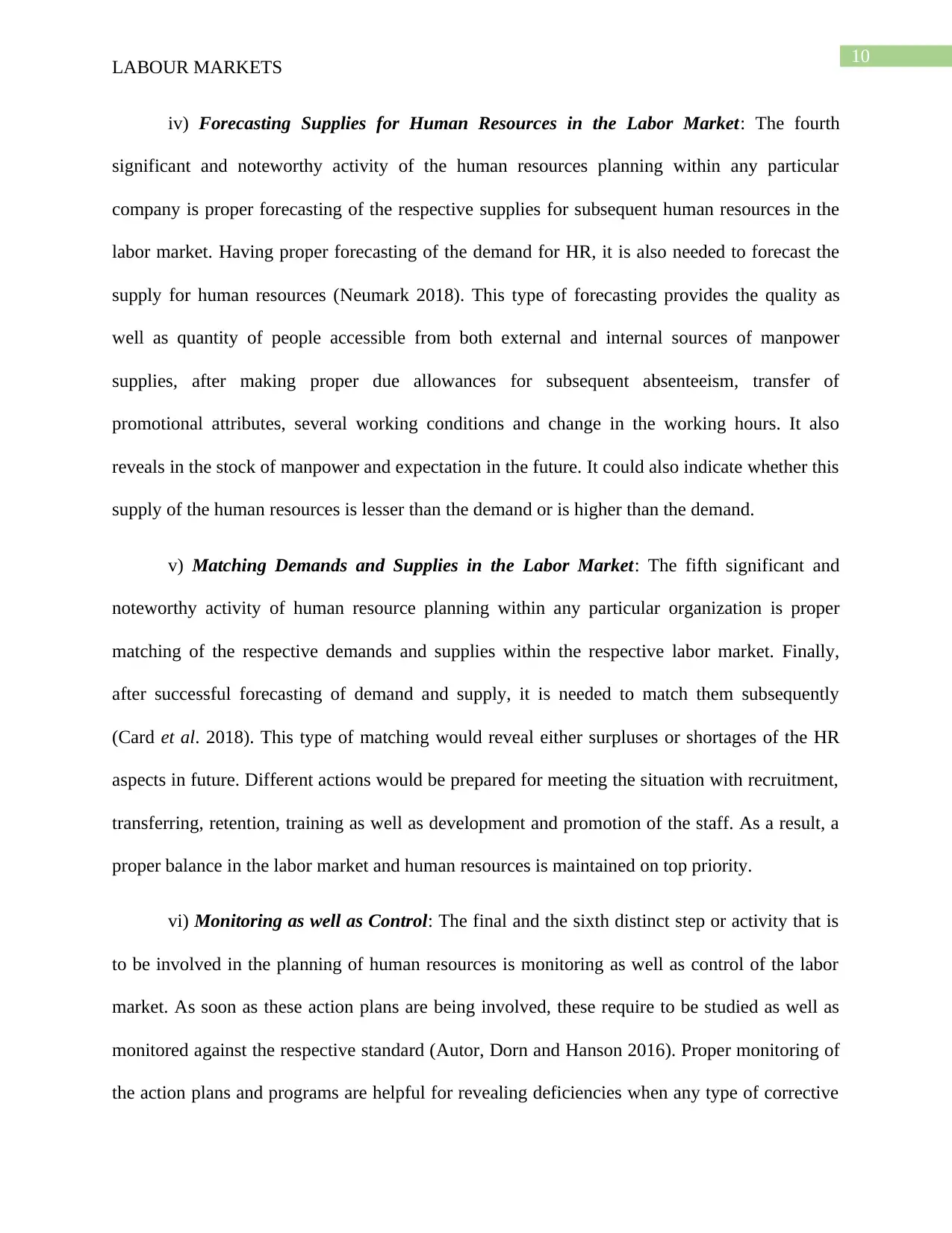
10
LABOUR MARKETS
iv) Forecasting Supplies for Human Resources in the Labor Market: The fourth
significant and noteworthy activity of the human resources planning within any particular
company is proper forecasting of the respective supplies for subsequent human resources in the
labor market. Having proper forecasting of the demand for HR, it is also needed to forecast the
supply for human resources (Neumark 2018). This type of forecasting provides the quality as
well as quantity of people accessible from both external and internal sources of manpower
supplies, after making proper due allowances for subsequent absenteeism, transfer of
promotional attributes, several working conditions and change in the working hours. It also
reveals in the stock of manpower and expectation in the future. It could also indicate whether this
supply of the human resources is lesser than the demand or is higher than the demand.
v) Matching Demands and Supplies in the Labor Market: The fifth significant and
noteworthy activity of human resource planning within any particular organization is proper
matching of the respective demands and supplies within the respective labor market. Finally,
after successful forecasting of demand and supply, it is needed to match them subsequently
(Card et al. 2018). This type of matching would reveal either surpluses or shortages of the HR
aspects in future. Different actions would be prepared for meeting the situation with recruitment,
transferring, retention, training as well as development and promotion of the staff. As a result, a
proper balance in the labor market and human resources is maintained on top priority.
vi) Monitoring as well as Control: The final and the sixth distinct step or activity that is
to be involved in the planning of human resources is monitoring as well as control of the labor
market. As soon as these action plans are being involved, these require to be studied as well as
monitored against the respective standard (Autor, Dorn and Hanson 2016). Proper monitoring of
the action plans and programs are helpful for revealing deficiencies when any type of corrective
LABOUR MARKETS
iv) Forecasting Supplies for Human Resources in the Labor Market: The fourth
significant and noteworthy activity of the human resources planning within any particular
company is proper forecasting of the respective supplies for subsequent human resources in the
labor market. Having proper forecasting of the demand for HR, it is also needed to forecast the
supply for human resources (Neumark 2018). This type of forecasting provides the quality as
well as quantity of people accessible from both external and internal sources of manpower
supplies, after making proper due allowances for subsequent absenteeism, transfer of
promotional attributes, several working conditions and change in the working hours. It also
reveals in the stock of manpower and expectation in the future. It could also indicate whether this
supply of the human resources is lesser than the demand or is higher than the demand.
v) Matching Demands and Supplies in the Labor Market: The fifth significant and
noteworthy activity of human resource planning within any particular organization is proper
matching of the respective demands and supplies within the respective labor market. Finally,
after successful forecasting of demand and supply, it is needed to match them subsequently
(Card et al. 2018). This type of matching would reveal either surpluses or shortages of the HR
aspects in future. Different actions would be prepared for meeting the situation with recruitment,
transferring, retention, training as well as development and promotion of the staff. As a result, a
proper balance in the labor market and human resources is maintained on top priority.
vi) Monitoring as well as Control: The final and the sixth distinct step or activity that is
to be involved in the planning of human resources is monitoring as well as control of the labor
market. As soon as these action plans are being involved, these require to be studied as well as
monitored against the respective standard (Autor, Dorn and Hanson 2016). Proper monitoring of
the action plans and programs are helpful for revealing deficiencies when any type of corrective
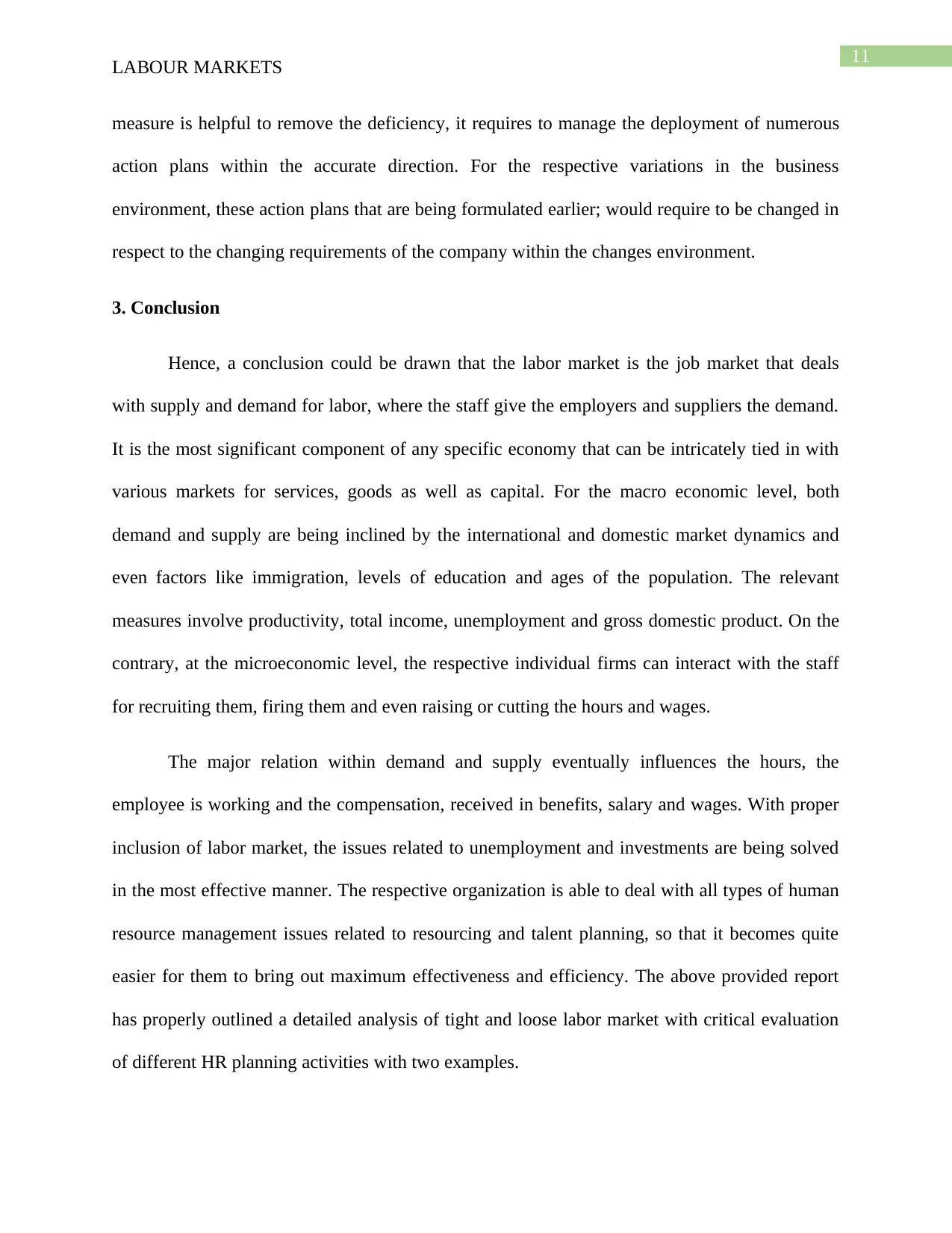
11
LABOUR MARKETS
measure is helpful to remove the deficiency, it requires to manage the deployment of numerous
action plans within the accurate direction. For the respective variations in the business
environment, these action plans that are being formulated earlier; would require to be changed in
respect to the changing requirements of the company within the changes environment.
3. Conclusion
Hence, a conclusion could be drawn that the labor market is the job market that deals
with supply and demand for labor, where the staff give the employers and suppliers the demand.
It is the most significant component of any specific economy that can be intricately tied in with
various markets for services, goods as well as capital. For the macro economic level, both
demand and supply are being inclined by the international and domestic market dynamics and
even factors like immigration, levels of education and ages of the population. The relevant
measures involve productivity, total income, unemployment and gross domestic product. On the
contrary, at the microeconomic level, the respective individual firms can interact with the staff
for recruiting them, firing them and even raising or cutting the hours and wages.
The major relation within demand and supply eventually influences the hours, the
employee is working and the compensation, received in benefits, salary and wages. With proper
inclusion of labor market, the issues related to unemployment and investments are being solved
in the most effective manner. The respective organization is able to deal with all types of human
resource management issues related to resourcing and talent planning, so that it becomes quite
easier for them to bring out maximum effectiveness and efficiency. The above provided report
has properly outlined a detailed analysis of tight and loose labor market with critical evaluation
of different HR planning activities with two examples.
LABOUR MARKETS
measure is helpful to remove the deficiency, it requires to manage the deployment of numerous
action plans within the accurate direction. For the respective variations in the business
environment, these action plans that are being formulated earlier; would require to be changed in
respect to the changing requirements of the company within the changes environment.
3. Conclusion
Hence, a conclusion could be drawn that the labor market is the job market that deals
with supply and demand for labor, where the staff give the employers and suppliers the demand.
It is the most significant component of any specific economy that can be intricately tied in with
various markets for services, goods as well as capital. For the macro economic level, both
demand and supply are being inclined by the international and domestic market dynamics and
even factors like immigration, levels of education and ages of the population. The relevant
measures involve productivity, total income, unemployment and gross domestic product. On the
contrary, at the microeconomic level, the respective individual firms can interact with the staff
for recruiting them, firing them and even raising or cutting the hours and wages.
The major relation within demand and supply eventually influences the hours, the
employee is working and the compensation, received in benefits, salary and wages. With proper
inclusion of labor market, the issues related to unemployment and investments are being solved
in the most effective manner. The respective organization is able to deal with all types of human
resource management issues related to resourcing and talent planning, so that it becomes quite
easier for them to bring out maximum effectiveness and efficiency. The above provided report
has properly outlined a detailed analysis of tight and loose labor market with critical evaluation
of different HR planning activities with two examples.
⊘ This is a preview!⊘
Do you want full access?
Subscribe today to unlock all pages.

Trusted by 1+ million students worldwide
1 out of 16
Related Documents
Your All-in-One AI-Powered Toolkit for Academic Success.
+13062052269
info@desklib.com
Available 24*7 on WhatsApp / Email
![[object Object]](/_next/static/media/star-bottom.7253800d.svg)
Unlock your academic potential
Copyright © 2020–2025 A2Z Services. All Rights Reserved. Developed and managed by ZUCOL.





